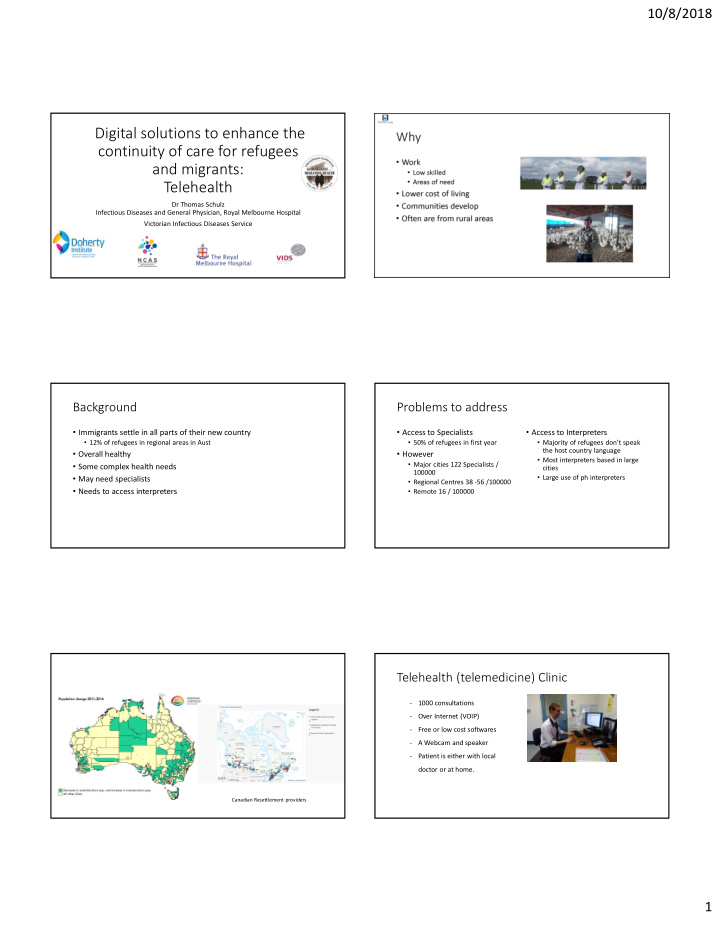



10/8/2018 DSC6699-31.jpg Digital solutions to enhance the Why continuity of care for refugees • Work and migrants: • Low skilled • Areas of need Telehealth • Lower cost of living • Communities develop Dr Thomas Schulz Infectious Diseases and General Physician, Royal Melbourne Hospital • Often are from rural areas Victorian Infectious Diseases Service Background Problems to address • Immigrants settle in all parts of their new country • Access to Specialists • Access to Interpreters • 12% of refugees in regional areas in Aust • 50% of refugees in first year • Majority of refugees don’t speak the host country language • Overall healthy • However • Most interpreters based in large • Major cities 122 Specialists / • Some complex health needs cities 100000 • May need specialists • Large use of ph interpreters • Regional Centres 38 -56 /100000 • Needs to access interpreters • Remote 16 / 100000 Telehealth (telemedicine) Clinic - 1000 consultations - Over Internet (VOIP) - Free or low cost softwares - A Webcam and speaker - Patient is either with local doctor or at home. Canadian Resettlement providers 1
10/8/2018 Method of provision of Interpreter service for How it works clinical consultations • Medication – Send prescription for medication (or send medication) • Pathology and Radiology – send request form • Interpreters on the phone at the Regional site • Sometimes need to see onsite Benefits Patient and consultation variables • Reduced patient travel/time 39 (IQR * 32 – 49) Median Age • in first year; Number of males 75 – Over 54000km travel avoided Number of females 44 – Median distance saved 494km/consultation – 15200kg CO2 not emitted (if all by car) Consultations with GP with patient 91 • Better communication with GP’s GP’s who conducted at least one consultation 29 • Patients very happy Consultations with practice nurse with patient 28 494km (IQR * 188 – 648km) Median return distance from GP practice to tertiary hospital Green Vehicle Guide, Aust Greenhouse office Medical conditions managed during telehealth consultations. Technical issues experienced during consultations IT issues - Less with time - Practice - It is getting easier - Passwords are a problem - Onsite is simplest to schedule - Simplicity is crucial 2
10/8/2018 Figure 2: Rated quality Figure 1: Rated quality of a multipoint of a multipoint videoconference at varying bandwidths • Randomised trial videoconference at (score of 3 or more represents an varying latencies adequate consultation) • Chinese immigrants with depression • Used Bilingual Specialists • Model of collaborative care Yeung et al J Clin Psych 2016 Is Telehealth effective Opportunities • We know: • Mental Health • Need to increase use – It’s cheaper – Large issue for refugee arrivals • Ontario – Patients like it – Needs ongoing care – Immigrants 11% use – Clinicians like it – Local population 22% use – It’s good for the environment – Lack of local language interpreters a – But do patient’s get good clinical barrier care? (Batista 2013 poster) Number of Patients Sustained Virological Response Failed treatment (%) Lost to follow up/ceased/did Improving access to interpreters (%) not start (%) All 58 51 (88%) 1 (2%) 4 (7%)/1 (2%)/1 (2%) Hep C treated via • 28% of Australians were not born in Australia Male 44 39 (89%) 0 4 (9%)/1(2%)/0 Female 14 12 (86%) 1 (7%) 0/0/1(7%) telehealth – Many do not speak English Genotype 1 36 35 (97%) 0 1(3%)/0/0 Genotype 2 1 1 (100%) 0 0 • 200000 immigrants to Australia each year In combination Genotype 3 20 15 (75%) 1 (5%) 3(15%)/0/1 (5%) – Most from Non- English speaking with onsite visits Genotype 6 1 0 (0%) 0 0/1(100%)/0 countries HIV Co-infection 2 2 (100%) 0 0 Cirrhosis 11 11 (100%) 0 0 • 15000 refugees annually Previous failed Treatment 13 11 (85%) 0 2 (15%)/0/0 – Most do not speak English Started treatment at onsite visit 34 30 (88%) 1 (3%) 2 (6%)/1 (3%) /0 Started treatment via telehealth 24 21 (88%) 0 2 (8%)/0/1 (4%) Schulz J Telemed 2018 3
10/8/2018 Need for professional interpreters? • Median 11 months in Australia • Only 60% of interpreters in first language • Quality of care • Legal considerations – Reduced length of stay – American Civil Rights act – Reduced readmissions – Multiple guidelines – Reduced clinical errors – Legal payout’s – Improve clinical outcomes – Increase patient comprehension – Increased patient satisfaction It’s harder but its worth the effort!! Improving Interpreter Access Specialist Interpreter Patient 1 Phone link Video-conference link 2 4 (New) 3 (New) Interpreter via video survey Ethnicity • Survey’s of patients and doctors – patient survey conducted by interpreter’s after consult • 50 patients – 43 video consults – 7 multipoint video consults • Median patient age 31 • 51% female 4
10/8/2018 The future Patient comparisons • Interpreter’s who are mobile joining by videoconference – Tablet? – Confidentiality? – International? – Phone apps to translate? • A real opportunity to improve health care for immigrants 19% concerned the doctor may have missed something Tuckson NEJM 2017 Doctor’s comparisons Thankyou Conclusion • Including an interpreter via video is well accepted and preferred to phone interpreting • Having the interpreter onsite remains the ideal for both patients and doctors • Great potential for improving access, especially rural areas • Slightly more complicated to organise 5
Recommend
More recommend